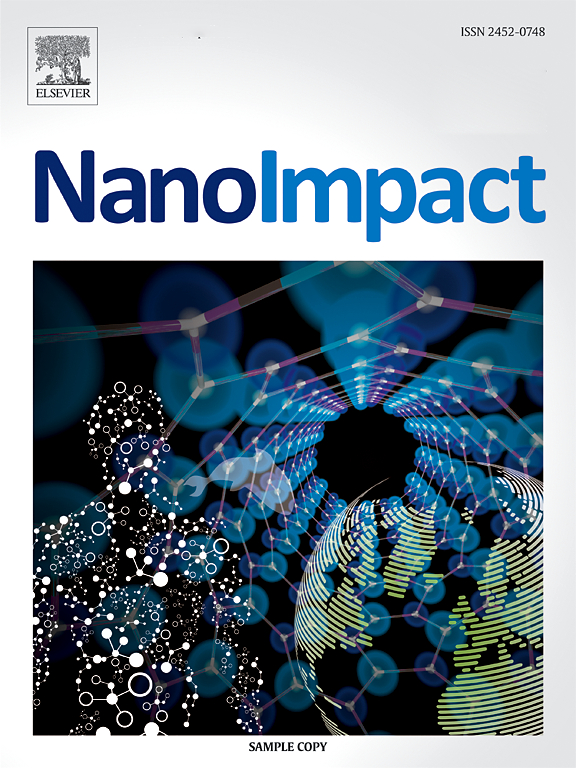在实验性结肠炎小鼠中,二氧化钛纳米颗粒驱动增强的促炎症反应,加重氧化损伤和肠道微生物群失调。
IF 5.5
3区 环境科学与生态学
Q2 ENVIRONMENTAL SCIENCES
引用次数: 0
摘要
随着二氧化钛纳米颗粒(TiO2 NPs)在食品中的广泛应用,炎症性肠病(IBD)不可避免地会被摄入。在这项工作中,我们每天给小鼠服用TiO2 NPs,然后饮用葡聚糖硫酸钠(DSS) 7 天,以获得结肠炎模型。tio_2 NPs暴露的结肠炎小鼠出现兴奋性结肠长度缩短、体重减轻早、体重减轻、疾病活动指数评分增高、病理结构紊乱。此外,在结肠中检测到炎症细胞因子过量产生和氧化损伤的显著变化。16S rDNA测序结果表明,TiO2 NPs破坏了肠道菌群平衡,导致α-多样性指数下降,总操作分类单位(OTUs)数量减少,群落分布和组成发生改变。为了找到关键的细菌调节因子,我们进一步分析了差异种的丰度变化,发现产生短链脂肪酸(SCFAs)的细菌(Muribaculaceae、Ruminococcus、Clostridia等)的相对丰度明显降低,而致病菌(Gastranaerophilaceae、Helicobacter、Escherichia-Shigella等)的相对丰度显著增加。scfa的减少和炎症因子的升高相互作用,诱导炎症-氧化级联循环的形成。我们的工作强调了膳食纳米颗粒对IBD人群的风险评估,并确定了关键的微生物调节因子,期望为受环境因素影响的IBD提供靶向治疗策略。本文章由计算机程序翻译,如有差异,请以英文原文为准。

Titanium dioxide nanoparticles drive the enhanced pro-inflammation response, worsening oxidative injure and gut microbiota dysbiosis in experimental colitis mice
With the wide use of titanium dioxide nanoparticles (TiO2 NPs) in food products, inflammatory bowel disease (IBD) was inevitably to ingest it. In this work, we daily administered TiO2 NPs to mice, followed by dextran sulfate sodium (DSS)-drinking for 7 days to obtain the colitis model. Excitedly, shorten colon length, earlier and increased weigh body loss, higher disease activity index score, as well as disorganized pathological structure were observed in colitis mice with TiO2 NPs exposure. Moreover, the significant changes in overproduction of inflammatory cytokines and oxidative injure were detected in colon. 16S rDNA sequencing results showed that TiO2 NPs broke the balance of gut microbiota, including decreased α-diversity index, reduced the total operational taxonomic units (OTUs) number and altered the community distribution and compositions. To find the key bacterial regulator, we further analyzed the abundance change of differential species, found that the relative abundance of short-chain fatty acid (SCFAs)-producing bacteria (Muribaculaceae, Ruminococcus, Clostridia, etc.) noticeably reduced, while the relative abundance of pathogenic bacteria (Gastranaerophilaceae, Helicobacter, Escherichia-Shigella, etc.) dramatically augmented. The mutual cooperation of reduced SCFAs and elevated inflammatory factors induced the form of inflammation-oxidative cascade cycle. Our work highlighted the risk assessment of dietary nanoparticles on the IBD population and identified the key microbial regulators, looking forward to provide the target therapeutic strategies for IBD affected by environmental factors.
求助全文
通过发布文献求助,成功后即可免费获取论文全文。
去求助
来源期刊

NanoImpact
Social Sciences-Safety Research
CiteScore
11.00
自引率
6.10%
发文量
69
审稿时长
23 days
期刊介绍:
NanoImpact is a multidisciplinary journal that focuses on nanosafety research and areas related to the impacts of manufactured nanomaterials on human and environmental systems and the behavior of nanomaterials in these systems.
 求助内容:
求助内容: 应助结果提醒方式:
应助结果提醒方式:


